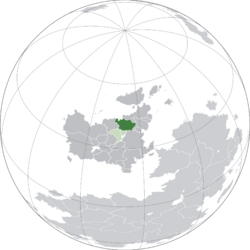Kirenia: Difference between revisions
mNo edit summary |
No edit summary |
||
| Line 2: | Line 2: | ||
{{Region icon Kylaris}} | {{Region icon Kylaris}} | ||
{{Infobox country | {{Infobox country | ||
|native_name = '' | |native_name = ''Kiiremaa Volikogu Vabariik'' <br><small>({{wp|Estonian_language|Kirenian}})</small> | ||
|conventional_long_name = Kirenian Council Republic | |conventional_long_name = Kirenian Council Republic | ||
|common_name = Kirenia | |common_name = Kirenia | ||
| Line 34: | Line 34: | ||
|ethnic_groups_year = 2018 | |ethnic_groups_year = 2018 | ||
|demonym = Kirenian | |demonym = Kirenian | ||
|government_type = {{wp|Unitary state|Unitary}} {{wp|socialism|socialist}} {{wp|Soviet democracy| | |government_type = {{wp|Unitary state|Unitary}} {{wp|socialism|socialist}} {{wp|Soviet democracy|council republic}} | ||
|leader_title1 = | |leader_title1 = | ||
|leader_name1 = | |leader_name1 = | ||
| Line 103: | Line 103: | ||
}} | }} | ||
'''Kirenia''' ({{wp|International_Phonetic _Alphabet_chart_for_English_dialects|/kirenia/}}; {{wp|Estonian_language|Kirenian}}: '' | '''Kirenia''' ({{wp|International_Phonetic _Alphabet_chart_for_English_dialects|/kirenia/}}; {{wp|Estonian_language|Kirenian}}: ''Kiiremaa'', {{small|pronounced}} {{wp|IPA-kii|/kiiremaa/}}), officially the '''Kirenian Council Republic''' ({{wp|Estonian_language|Kirenian}}: ''Kiiremaa Volikogu Vabariik'') is a {{wp|unitary state|unitary}} {{wp|socialism|socialist}} {{wp|Soviet democracy|council republic}} located in Northern [[Euclea]]. It shares borders with [[Werania]], [[Estmere]] and [[Kesselbourg]] to the east, while also bordering [[Gaullica]], [[Aimilia]] and [[East Miersa]] to the south. | ||
Kirenia is recognised as the homeland of {{wp|socialism}} in [[Kylaris|the world]], participating in the [[Mutual Assistance Organisation]] and the [[Association for International Socialism]]. Additionally, it is a member of the [[International Council for Democracy]] and the [[Community of Nations]], with a permanent seat on the [[Community of Nations#Security Committee|Security Committee]]. Kirenia is a {{wp|great power}} and — in accordance with the [[Treaty of Shanbally]] — is one of the seven nuclear-capable nations mandated by the Community of Nations. | |||
__TOC__ | __TOC__ | ||
==Etymology== | |||
''Kirenia'' is the {{wp|Anglicised|Estmericised}} form of the native ''Kiiremaa'', meaning "land of the [River] Kiire". The name of the Kiire derives from the {{wp|Proto-Germanic|Proto-Weranic}} ''*gīraz'', and was popularly used by the states of the [[Rudolphine Confederation]] during the {{wp|Early Middle Ages}} before entering mainstream usage in Kirenian. | |||
Prior to the [[April Revolution]], the form ''Cirenia'' was common amongst the states of Eastern Euclea, but the installation of the revolutionary government saw a policy of Kirenisation and ''Kirenia'' was chosen as the official Estmerish name in 1920. | |||
==History== | |||
===Revolutionary period (1910–1950)=== | |||
* Great Collapse (1913) causes large-scale economic downturn | |||
* Juhan VII abdicates | |||
* April Revolution occurs | |||
* Councilists enlist the support of other smaller factions, ultimately culminating in their success | |||
* Entry into the [[Great War (Kylaris)|Great War]] on the side of the Alliance (1931) | |||
* Kirenian support of [[East Miersa]] as per the Godfredson Plan | |||
* Kirenian-Weranian War (1949–1950) results in Kirenian victory; subsequent ''Katkos-1'' test sees development of nuclear weapons | |||
===Contemporary period (1950–present)=== | |||
• Kirenia support of East Miersa during the [[Miersan War]] | |||
[[Category:Kirenia]] | [[Category:Kirenia]] | ||
[[Category:Kylaris]] | [[Category:Kylaris]] | ||
[[Category:Countries]] | [[Category:Countries]] | ||
Revision as of 13:31, 22 August 2020
This article is incomplete because it is pending further input from participants, or it is a work-in-progress by one author. Please comment on this article's talk page to share your input, comments and questions. Note: To contribute to this article, you may need to seek help from the author(s) of this page. |
Kirenian Council Republic Kiiremaa Volikogu Vabariik (Kirenian) | |
|---|---|
|
Flag | |
 | |
| Official languages | Kirenian |
| Demonym(s) | Kirenian |
| Government | Unitary socialist council republic |
| Legislature | Suur Volikogu |
| Population | |
• Census | 50,000,000 |
| GDP (PPP) | estimate |
• Total | $2.000 trillion |
• Per capita | $40,000 |
| GDP (nominal) | 2020 estimate |
• Total | $2.400 trillion |
• Per capita | $48,000 |
| Time zone | UTC-1 |
• Summer (DST) | UTC0 |
| Date format | dd-mm-yyyy (CE) |
| Driving side | right |
Kirenia (/kirenia/; Kirenian: Kiiremaa, pronounced /kiiremaa/), officially the Kirenian Council Republic (Kirenian: Kiiremaa Volikogu Vabariik) is a unitary socialist council republic located in Northern Euclea. It shares borders with Werania, Estmere and Kesselbourg to the east, while also bordering Gaullica, Aimilia and East Miersa to the south.
Kirenia is recognised as the homeland of socialism in the world, participating in the Mutual Assistance Organisation and the Association for International Socialism. Additionally, it is a member of the International Council for Democracy and the Community of Nations, with a permanent seat on the Security Committee. Kirenia is a great power and — in accordance with the Treaty of Shanbally — is one of the seven nuclear-capable nations mandated by the Community of Nations.
Etymology
Kirenia is the Estmericised form of the native Kiiremaa, meaning "land of the [River] Kiire". The name of the Kiire derives from the Proto-Weranic *gīraz, and was popularly used by the states of the Rudolphine Confederation during the Early Middle Ages before entering mainstream usage in Kirenian.
Prior to the April Revolution, the form Cirenia was common amongst the states of Eastern Euclea, but the installation of the revolutionary government saw a policy of Kirenisation and Kirenia was chosen as the official Estmerish name in 1920.
History
Revolutionary period (1910–1950)
- Great Collapse (1913) causes large-scale economic downturn
- Juhan VII abdicates
- April Revolution occurs
- Councilists enlist the support of other smaller factions, ultimately culminating in their success
- Entry into the Great War on the side of the Alliance (1931)
- Kirenian support of East Miersa as per the Godfredson Plan
- Kirenian-Weranian War (1949–1950) results in Kirenian victory; subsequent Katkos-1 test sees development of nuclear weapons
Contemporary period (1950–present)
• Kirenia support of East Miersa during the Miersan War
